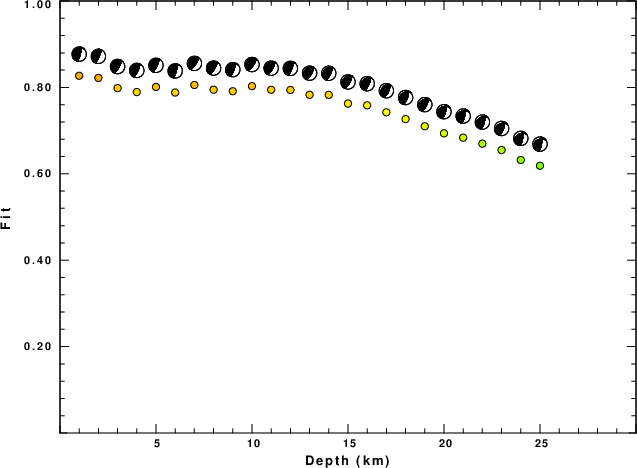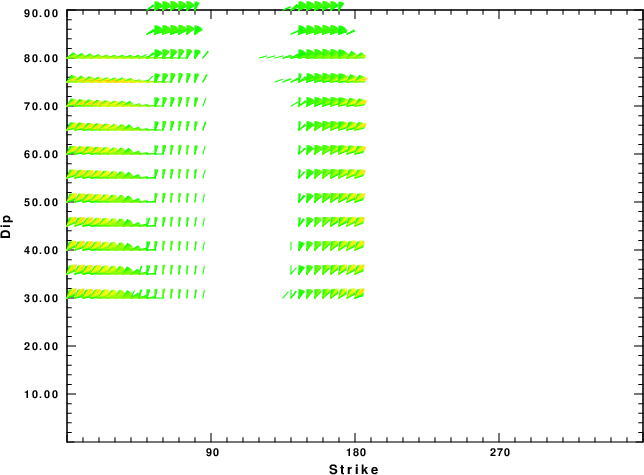
The ANSS event ID is ci12245763 and the event page is at https://earthquake.usgs.gov/earthquakes/eventpage/ci12245763/executive.
2006/05/24 04:20:27 32.307 -115.228 6.0 5.37 Baja California, Mexico
USGS/SLU Moment Tensor Solution
ENS 2006/05/24 04:20:27:0 32.31 -115.23 6.0 5.4 Baja California, Mexico
Stations used:
CI.BAR CI.GLA CI.GSC CI.MWC LB.DAC LB.MVU LB.TPH US.ISA
US.MNV US.TUC
Filtering commands used:
cut o DIST/3.3 -30 o DIST/3.3 +90
rtr
taper w 0.1
hp c 0.03 n 3
lp c 0.05 n 3
Best Fitting Double Couple
Mo = 4.90e+23 dyne-cm
Mw = 5.06
Z = 2 km
Plane Strike Dip Rake
NP1 36 50 -86
NP2 210 40 -95
Principal Axes:
Axis Value Plunge Azimuth
T 4.90e+23 5 124
N 0.00e+00 3 214
P -4.90e+23 84 336
Moment Tensor: (dyne-cm)
Component Value
Mxx 1.44e+23
Mxy -2.22e+23
Mxz -7.07e+22
Myy 3.37e+23
Myz 5.70e+22
Mzz -4.81e+23
##############
###############-------
#############--------------#
###########-----------------##
###########--------------------###
##########----------------------####
##########-----------------------#####
#########------------------------#######
########-------------------------#######
#########---------- ------------########
########----------- P -----------#########
#######------------ ----------##########
#######------------------------###########
######-----------------------###########
######----------------------############
#####--------------------######### #
####------------------########### T
####---------------#############
##------------################
##-------###################
######################
##############
Global CMT Convention Moment Tensor:
R T P
-4.81e+23 -7.07e+22 -5.70e+22
-7.07e+22 1.44e+23 2.22e+23
-5.70e+22 2.22e+23 3.37e+23
Details of the solution is found at
http://www.eas.slu.edu/eqc/eqc_mt/MECH.NA/20060524042027/index.html
|
STK = 210
DIP = 40
RAKE = -95
MW = 5.06
HS = 2.0
The NDK file is 20060524042027.ndk The waveform inversion is preferred.
The following compares this source inversion to those provided by others. The purpose is to look for major differences and also to note slight differences that might be inherent to the processing procedure. For completeness the USGS/SLU solution is repeated from above.
USGS/SLU Moment Tensor Solution
ENS 2006/05/24 04:20:27:0 32.31 -115.23 6.0 5.4 Baja California, Mexico
Stations used:
CI.BAR CI.GLA CI.GSC CI.MWC LB.DAC LB.MVU LB.TPH US.ISA
US.MNV US.TUC
Filtering commands used:
cut o DIST/3.3 -30 o DIST/3.3 +90
rtr
taper w 0.1
hp c 0.03 n 3
lp c 0.05 n 3
Best Fitting Double Couple
Mo = 4.90e+23 dyne-cm
Mw = 5.06
Z = 2 km
Plane Strike Dip Rake
NP1 36 50 -86
NP2 210 40 -95
Principal Axes:
Axis Value Plunge Azimuth
T 4.90e+23 5 124
N 0.00e+00 3 214
P -4.90e+23 84 336
Moment Tensor: (dyne-cm)
Component Value
Mxx 1.44e+23
Mxy -2.22e+23
Mxz -7.07e+22
Myy 3.37e+23
Myz 5.70e+22
Mzz -4.81e+23
##############
###############-------
#############--------------#
###########-----------------##
###########--------------------###
##########----------------------####
##########-----------------------#####
#########------------------------#######
########-------------------------#######
#########---------- ------------########
########----------- P -----------#########
#######------------ ----------##########
#######------------------------###########
######-----------------------###########
######----------------------############
#####--------------------######### #
####------------------########### T
####---------------#############
##------------################
##-------###################
######################
##############
Global CMT Convention Moment Tensor:
R T P
-4.81e+23 -7.07e+22 -5.70e+22
-7.07e+22 1.44e+23 2.22e+23
-5.70e+22 2.22e+23 3.37e+23
Details of the solution is found at
http://www.eas.slu.edu/eqc/eqc_mt/MECH.NA/20060524042027/index.html
|
** SCSN Moment Tensor Solution Message **
REAL-TIME SOLUTION: OPERATOR REVIEWED
Reviewed On: 05/24/2006 17:46:8
Inversion Method: Complete Waveform
Number of Stations used: 6
Stations: CI.IRM CI.BAR CI.DVT AZ.YAQ CI.SWS CI.RXH
Real-Time Solution:
-------------------
Event ID : 12245763
Magnitude : 5.16
Depth (km) : 6.0
Origin Time : 05/24/2006 04:20:26:010
Latitude : 32.31
Longitude : -115.23
Further Information at: http://pasadena.wr.usgs.gov/recenteqs/Quakes/ci12245763.htm
SCSN Moment Tensor Solution:
----------------------------
Moment Magnitude : 5.37
Depth (km) : 5
Variance Reduction(%): 81.12
Quality Factor : A
(A : Mw, MT good enough for distribution)
(B : Mw only good enough for distribution)
(C : Solution needs review before distribution)
Best Fitting Double Couple and CLVD Solution:
---------------------------------------------------
Moment Tensor: Scale = 10**21 Dyne-cm
Component Value
Mxx 436
Mxy -487
Mxz 67.1
Myy 886
Myz 23.7
Mzz -1320
Best Fitting Double Couple Solution:
--------------------------------------------------
Moment Tensor: Scale = 10**24 Dyne-cm
Component Value
Mxx 0.403
Mxy -0.646
Mxz 0.058
Myy 1.023
Myz 0.040
Mzz -1.425
Principle Axes:
Axis Value Plunge Azimuth
T 1.429 0 122
N 0.000 3 32
P -1.429 87 214
Best Fitting Double-Couple:
Mo = 1.43E+24 Dyne-cm
Plane Strike Rake Dip
NP1 29 -94 45
NP2 215 -86 45
Moment Magnitude = 5.37
#######
###################
####################---##
################----------###
###############-------------#####
##############----------------#####
#############------------------######
############--------------------#######
###########---------------------#######
###########----------------------########
##########--------- ----------#########
#########---------- P ----------#########
########----------- ---------##########
########----------------------###########
######----------------------###########
######---------------------############
#####--------------------#########
####------------------########### T
###----------------#############
##------------###############
#--------################
###################
#######
Lower Hemisphere Equiangle Projection
============= Station Information ==============
Name Distance Azimuth VR ZCore
-------------------------------------------------
CI.IRM 205.002 2.188 74.911 24.00
CI.BAR 141.595 287.227 82.649 20.00
CI.DVT 90.517 295.551 84.515 12.00
AZ.YAQ 141.825 312.342 80.599 19.00
CI.SWS 87.807 322.948 79.474 10.00
CI.RXH 103.562 339.298 82.430 11.00
|
 |
The focal mechanism was determined using broadband seismic waveforms. The location of the event (star) and the stations used for (red) the waveform inversion are shown in the next figure.

|
|
|
The program wvfgrd96 was used with good traces observed at short distance to determine the focal mechanism, depth and seismic moment. This technique requires a high quality signal and well determined velocity model for the Green's functions. To the extent that these are the quality data, this type of mechanism should be preferred over the radiation pattern technique which requires the separate step of defining the pressure and tension quadrants and the correct strike.
The observed and predicted traces are filtered using the following gsac commands:
cut o DIST/3.3 -30 o DIST/3.3 +90 rtr taper w 0.1 hp c 0.03 n 3 lp c 0.05 n 3The results of this grid search are as follow:
DEPTH STK DIP RAKE MW FIT
WVFGRD96 1.0 215 40 -85 4.98 0.2309
WVFGRD96 2.0 210 40 -95 5.06 0.2661
WVFGRD96 3.0 40 55 -80 5.11 0.2465
WVFGRD96 4.0 40 55 -80 5.13 0.2135
WVFGRD96 5.0 240 30 -40 5.11 0.1988
WVFGRD96 6.0 245 30 -35 5.10 0.1997
WVFGRD96 7.0 250 25 -30 5.09 0.2056
WVFGRD96 8.0 245 25 -35 5.16 0.2165
WVFGRD96 9.0 250 20 -30 5.16 0.2257
WVFGRD96 10.0 260 20 -15 5.15 0.2342
WVFGRD96 11.0 260 20 -15 5.15 0.2411
WVFGRD96 12.0 265 20 -10 5.15 0.2471
WVFGRD96 13.0 270 20 -5 5.15 0.2515
WVFGRD96 14.0 275 20 0 5.16 0.2549
WVFGRD96 15.0 280 20 5 5.16 0.2571
WVFGRD96 16.0 280 20 5 5.17 0.2585
WVFGRD96 17.0 290 20 15 5.17 0.2592
WVFGRD96 18.0 295 20 20 5.18 0.2592
WVFGRD96 19.0 185 80 65 5.20 0.2612
WVFGRD96 20.0 185 80 65 5.21 0.2620
WVFGRD96 21.0 185 80 65 5.23 0.2614
WVFGRD96 22.0 185 80 65 5.23 0.2607
WVFGRD96 23.0 185 80 65 5.24 0.2593
WVFGRD96 24.0 185 80 65 5.24 0.2574
WVFGRD96 25.0 190 75 65 5.25 0.2552
WVFGRD96 26.0 200 70 70 5.25 0.2536
WVFGRD96 27.0 200 70 70 5.25 0.2524
WVFGRD96 28.0 200 65 70 5.26 0.2511
WVFGRD96 29.0 200 65 70 5.26 0.2498
The best solution is
WVFGRD96 2.0 210 40 -95 5.06 0.2661
The mechanism corresponding to the best fit is

|
|
|
The best fit as a function of depth is given in the following figure:

|
|
|
The comparison of the observed and predicted waveforms is given in the next figure. The red traces are the observed and the blue are the predicted. Each observed-predicted component is plotted to the same scale and peak amplitudes are indicated by the numbers to the left of each trace. A pair of numbers is given in black at the right of each predicted traces. The upper number it the time shift required for maximum correlation between the observed and predicted traces. This time shift is required because the synthetics are not computed at exactly the same distance as the observed, the velocity model used in the predictions may not be perfect and the epicentral parameters may be be off. A positive time shift indicates that the prediction is too fast and should be delayed to match the observed trace (shift to the right in this figure). A negative value indicates that the prediction is too slow. The lower number gives the percentage of variance reduction to characterize the individual goodness of fit (100% indicates a perfect fit).
The bandpass filter used in the processing and for the display was
cut o DIST/3.3 -30 o DIST/3.3 +90 rtr taper w 0.1 hp c 0.03 n 3 lp c 0.05 n 3

|
| Figure 3. Waveform comparison for selected depth. Red: observed; Blue - predicted. The time shift with respect to the model prediction is indicated. The percent of fit is also indicated. The time scale is relative to the first trace sample. |

|
| Focal mechanism sensitivity at the preferred depth. The red color indicates a very good fit to the waveforms. Each solution is plotted as a vector at a given value of strike and dip with the angle of the vector representing the rake angle, measured, with respect to the upward vertical (N) in the figure. |
A check on the assumed source location is possible by looking at the time shifts between the observed and predicted traces. The time shifts for waveform matching arise for several reasons:
Time_shift = A + B cos Azimuth + C Sin Azimuth
The time shifts for this inversion lead to the next figure:

The derived shift in origin time and epicentral coordinates are given at the bottom of the figure.
The following figure shows the stations used in the grid search for the best focal mechanism to fit the surface-wave spectral amplitudes of the Love and Rayleigh waves.

|
|
|
The surface-wave determined focal mechanism is shown here.
NODAL PLANES
STK= 10.00
DIP= 54.99
RAKE= -120.00
OR
STK= 235.18
DIP= 44.82
RAKE= -54.48
DEPTH = 1.0 km
Mw = 5.29
Best Fit 0.8217 - P-T axis plot gives solutions with FIT greater than FIT90
 |
Surface wave analysis was performed using codes from Computer Programs in Seismology, specifically the multiple filter analysis program do_mft and the surface-wave radiation pattern search program srfgrd96.
Digital data were collected, instrument response removed and traces converted
to Z, R an T components. Multiple filter analysis was applied to the Z and T traces to obtain the Rayleigh- and Love-wave spectral amplitudes, respectively.
These were input to the search program which examined all depths between 1 and 25 km
and all possible mechanisms.

|
|
|

|
| Pressure-tension axis trends. Since the surface-wave spectra search does not distinguish between P and T axes and since there is a 180 ambiguity in strike, all possible P and T axes are plotted. First motion data and waveforms will be used to select the preferred mechanism. The purpose of this plot is to provide an idea of the possible range of solutions. The P and T-axes for all mechanisms with goodness of fit greater than 0.9 FITMAX (above) are plotted here. |

|
| Focal mechanism sensitivity at the preferred depth. The red color indicates a very good fit to the Love and Rayleigh wave radiation patterns. Each solution is plotted as a vector at a given value of strike and dip with the angle of the vector representing the rake angle, measured, with respect to the upward vertical (N) in the figure. Because of the symmetry of the spectral amplitude rediation patterns, only strikes from 0-180 degrees are sampled. |

|

|
The WUS.model used for the waveform synthetic seismograms and for the surface wave eigenfunctions and dispersion is as follows (The format is in the model96 format of Computer Programs in Seismology).
MODEL.01
Model after 8 iterations
ISOTROPIC
KGS
FLAT EARTH
1-D
CONSTANT VELOCITY
LINE08
LINE09
LINE10
LINE11
H(KM) VP(KM/S) VS(KM/S) RHO(GM/CC) QP QS ETAP ETAS FREFP FREFS
1.9000 3.4065 2.0089 2.2150 0.302E-02 0.679E-02 0.00 0.00 1.00 1.00
6.1000 5.5445 3.2953 2.6089 0.349E-02 0.784E-02 0.00 0.00 1.00 1.00
13.0000 6.2708 3.7396 2.7812 0.212E-02 0.476E-02 0.00 0.00 1.00 1.00
19.0000 6.4075 3.7680 2.8223 0.111E-02 0.249E-02 0.00 0.00 1.00 1.00
0.0000 7.9000 4.6200 3.2760 0.164E-10 0.370E-10 0.00 0.00 1.00 1.00